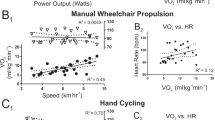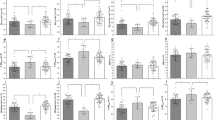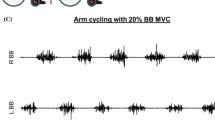Abstract
Study design: A paired comparison of the peak and submaximal responses of oxygen uptake and heart rate in patients with spinal cord injury (SCI) performing voluntary arm cycle exercise and functional electrical stimulation (FES) leg cycling exercise.
Objectives: To test if the blunted heart rate response and slower rate of adjustment of oxygen uptake seen in patients with SCI performing FES leg cycle exercise are also characteristic of arm exercise in these patients.
Methods: Eight paraplegics performed incremental and constant work rate (CWR) exercise with the legs and arms. Mean response times (MRT) for V˙o2 during exercise (on) and in recovery (off) were calculated from the breath-by-breath V˙o2 profile.
Results: Peak heart rate was higher during incremental arm exercise, and uncorrelated with that observed during incremental FES leg cycling. For the same increase in V˙o2, constant work rate arm exercise was associated with faster (and normal) V˙o2 kinetics, greater increase in heart rate, and lower end-exercise blood lactate, compared to FES leg cycling.
Conclusions: The consistently higher peak heart rate and V˙o2, and faster V˙o2 kinetics, for voluntary arm compared to FES leg cycle exercise suggest no intrinsic dysfunction of heart rate control in these paraplegics. Rather, these data suggest that during FES leg cycling the changes seen are due to some characteristic specific to the injury, such as reduced muscle mass and/or deconditioning of the remaining muscle.
Sponsorship: This research was supported by The Department of Veterans Affairs, Rehabilitation Research and Development Project #B603-RA.
Similar content being viewed by others
Log in or create a free account to read this content
Gain free access to this article, as well as selected content from this journal and more on nature.com
or
Author information
Authors and Affiliations
Rights and permissions
About this article
Cite this article
Barstow, T., Scremin, A., Mutton, D. et al. Peak and kinetic cardiorespiratory responses during arm and leg exercise in patients with spinal cord injury. Spinal Cord 38, 340–345 (2000). https://doi.org/10.1038/sj.sc.3101014
Published:
Issue date:
DOI: https://doi.org/10.1038/sj.sc.3101014
Keywords
This article is cited by
-
Rethinking aerobic exercise intensity prescription in adults with spinal cord injury: time to end the use of “moderate to vigorous” intensity?
Spinal Cord (2022)
-
Investigating the Modulatory Role of Chronological and Biological Age on Performance Predictors in Youth Swimmers
Journal of Science in Sport and Exercise (2020)
-
Functional Electrical Stimulation: Cardiorespiratory Adaptations and Applications for Training in Paraplegia
Sports Medicine (2015)
-
Activity and Fitness in Spinal Cord Injury: Review and Update
Current Physical Medicine and Rehabilitation Reports (2014)
-
Physiological adaptations to exercise in people with spinal cord injury
Journal of Physiology and Biochemistry (2003)



